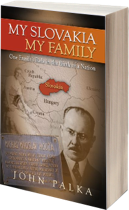The Author
Dr. John Palka is a retired professor of biology at the University of Washington with a specialty in neuroscience. He is the winner of numerous prestigious academic awards, including election as a Fellow of the American Association for the Advancement of Science, two Fulbright Fellowships for teaching in India, and a Guggenheim Fellowship for research in Cambridge, England. He also co-founded and co-directed the University of Washington’s highly lauded Program on the Environment.
A two-time refugee from his Slovak homeland—in 1939 from the Nazis and in 1949 from the Communists—Dr. Palka has retained his love for Slovakia and his fluency in the Slovak language. Since the fall of Communism in 1989, he has visited his family in Slovakia almost every year. These experiences inspired his research into the role that many generations of his family played in the national life of Slovakia, laying the foundation of his book My Slovakia, My Family: One Family’s Role in the Birth of a Nation.
Writing the Book
As My Slovakia, My Family recounts in some detail, I come from a Slovak family many of whose members made distinguished contributions to the development of the Slovak nation.

My Slovakia, My Family: One Family’s Role in the Birth of a Nation, portrait of Milan Hodža in the lower right.
For example, the cover of the book portrays my grandfather Dr. Milan Hodža, who was the prime minister of Czechoslovakia from 1935 to 1938, the years leading up to World War II. In the eyes of many historians, he was the most prominent Slovak political leader of the first half of the 20th century, and it is his life story that prompted me to write this book. Here is how it started.
A long-time professor of biology, I retired from the University of Washington in 2002 after more than 30 years of teaching, research, and program development. Within weeks, my wife Yvonne and I were thrown into a completely new world: we were guests on board the official airplane of the now-independent Slovak Republic, joining a delegation of government officials in accompanying Grandfather Hodža’s physical remains home to Slovakia. In recognition of my grandfather’s contributions to the development of the country, the Slovak government was transferring his remains with great ceremony from the Bohemian National Cemetery in Chicago, where he had been buried after his death in the United States in 1944, to the Slovak National Cemetery in the historic town of Martin.
For me, it was an unforgettable experience. I had grown up in the United States as a two-time immigrant whose family had fled two totalitarian regimes—the Nazis in 1939 and the Communists in 1949. After we settled in the New York City Borough of Queens, my mother told me many stories about my illustrious grandfather and other members of my remarkable family. So, growing up, I had at least a sketchy understanding of my family background. I also retained fluency in the Slovak language. Now, however, for the first time I was participating in events that publicly confirmed these stories. My family stories were becoming a lived reality.
Once I decided set down both my own experiences and the family story in writing, I was flooded with material, much of it very moving. Every time I went to Slovakia, new family connections, photographs, documents, and bits of oral history would emerge. Many U.S. immigrants searching for roots in their homelands are grateful to discover just the village from which one of their ancestors came. I, in contrast, could hardly take in everything that was offered to me. It was a grand exploration that still goes on. The book is my offering back from the bounty I have received.

